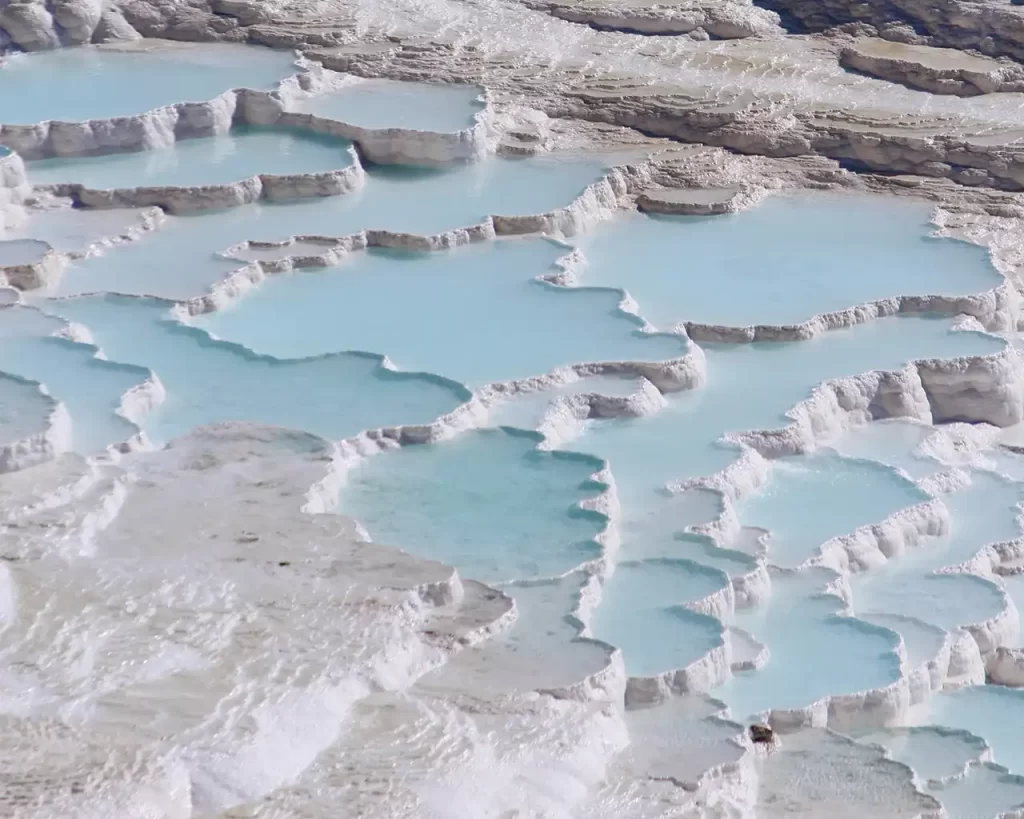Pamukkale
Pamukkale is a unique natural site located in southwestern Turkey. It is famous for its white, mineral-rich terraces and hot springs. The terraces are made of travertine, a sedimentary rock formed by the precipitation of calcium carbonate from the hot springs. The travertines have been shaped into stepped pools, creating a stunning, otherworldly landscape.
Pamukkale has been used as a spa since the Roman Empire and continues to be a popular tourist destination today. Visitors can bathe in the warm, mineral-rich waters of the hot springs, which are said to have therapeutic properties. In addition to the travertines and hot springs, Pamukkale also features the ancient city of Hierapolis, a well-preserved Roman city with ruins such as a theater, temple, and necropolis.
Pamukkale is a designated UNESCO World Heritage site and is considered one of Turkey’s top tourist attractions. Its unique beauty and historical significance make it a must-visit destination for those interested in natural wonders and ancient history.
Hierapolis Ancient City
Hierapolis was an ancient Roman city located near Pamukkale, Turkey. It was founded in the 2nd century BCE and was a center of worship for the cult of Apollo. In the following centuries, Hierapolis developed into a Roman city with various public structures, such as a theater, temple, and necropolis.
Hierapolis is also famous for its hot springs, which were believed to have therapeutic properties. The city was a popular spa destination, attracting visitors from all over the Roman Empire. In addition to its therapeutic hot springs, Hierapolis was also a center of textile production and a hub of commercial activity.
Many of Hierapolis’ ancient ruins have been well-preserved and can still be seen today. Visitors to the site can see the impressive theater, temple of Apollo, and the impressive Necropolis, a large cemetery containing hundreds of sarcophagi. The well-preserved ruins of Hierapolis offer a fascinating glimpse into the daily life of a Roman city and the importance of thermal springs in ancient times.
Hierapolis, along with the nearby travertines of Pamukkale, is a designated UNESCO World Heritage site and is a popular tourist destination in Turkey. The combination of stunning natural beauty and well-preserved ancient ruins make it a must-visit destination for those interested in history and archaeology.
What Period Does the Ancient City of Hierapolis Belong to?
Hierapolis Ancient City BC. It was founded by II. Eumenes in the 2nd century and was used as the center of the Apollon cult in Rome.
Where Is The Ancient City of Hierapolis Located?
The ancient city of Hierapolis is located near Pamukkale,Denizli in southwestern Turkey.
How To Get To The Ancient City of Hierapolis?
The ancient city of Hierapolis can be reached by several modes of transportation:
- By Air: The nearest airport to Hierapolis is the Denizli Çardak Airport, which is located approximately 50 km away. From there, visitors can take a taxi or rent a car to reach Hierapolis.
- By Bus: The ancient city is easily accessible by bus from many cities in Turkey, including Istanbul, Izmir, and Antalya.
- By Car: Hierapolis is located on the main highway connecting the cities of Izmir and Antalya, making it easily accessible by car.
- By Train: The nearest train station to Hierapolis is in Denizli, which is well connected to many cities in Turkey. From there, visitors can take a taxi or rent a car to reach Hierapolis.
Regardless of the mode of transportation chosen, reaching Hierapolis is relatively straightforward, and visitors can expect to find plenty of signage and tourist information to help them find their way.
Is There A Fee To Enter Hierapolis?
Yes, there is a fee to enter the ancient city of Hierapolis. The entrance fee is set by the Turkish government and is subject to change, so it is recommended to check the current fee before visiting. The fee usually covers access to the ancient ruins, including the theater, temples, and the Necropolis, as well as the hot springs and travertines of Pamukkale. It is important to note that the entrance fee for Hierapolis is separate from the entrance fee for Pamukkale, which is also a popular tourist destination in the area. Visitors should be prepared to pay separate fees for each site, or consider purchasing a combined ticket that covers both Hierapolis and Pamukkale.
When Did Hierapolis Excavation Work Start?
Excavation and restoration works initiated by Italian archaeologists in the 1950s in the ancient city of Hierapolis are carried out by a team led by Professor Francesco d’Andria from the University of Salento (Lecce, Italy). Nearly 100 experts from various countries, mainly from Italy and Turkey, work in the team. Among the most important works unearthed in Hierapolis to date are the Ancient Theatre, Necropolis, Hot Springs, the Great Church, the Martyrium of St. Philip, the Frontinus Gate, the Gymnasium, the Temple of Apollo and the Plutonium.
When Was Hierapolis Included in the UNESCO World Heritage List?
Hierapolis included in the UNESCO World Heritage List in 1988.
Parts of the Ancient City of Hierapolis
Hierapolis is an ancient city located today in Pamukkale, Turkey. Among the important parts of Hierapolis:
Hierapolis Theatre: The great structure was built on four islands. The vertical part, called the cavea diazoma, is divided into two. Summa Cavea, which is called its gallery with 9 cuneus in one of the two parts, is placed on 8 steps. The middle part of the Ima Cavea (lower steps) is arranged in a marble exedra, with high-backed, lion-footed seats. These seats are for the important people of the city. The theater is connected to the stage building, which has a logeion and a large backstage, and is connected to the skene. The three orders of the skene frons are located on the podium by marble monolith columns, with decorated cornices dedicated to Apollo and Artemis. This magnificent structure was built during the reign of Emperor Septimius Severus, III. It was built in the 19th century by engulfing and destroying the old phase (Flavian Period). It was used until the Late Roman Period, and this is determined from the inscriptions of the date on the underside of the architrave and the repair of the skene frons.
Ancient Thermal Baths: The massive walls of the building and some vaults are still standing. It is a building whose interiors are understood to be covered with marble. The bath has the plan of typical Roman baths. First, there is a large courtyard, on both sides of which there is a closed area covered with large rooms. Afterwards, there is the main bath section. In the side wings of the palaestra, two great halls, the south and north rooms, were reserved for emperors and ceremonies. The remains of the baths are dated to the middle of the 2nd century. The large rooms are used as vaulted indoor spaces today and are open as a museum.
Plutonium: Plutonium, one of the important cult places of Hierapolis, was a temple used for goddesses and gods in the ancient Roman period.
Ancient Agora: The ancient agora, the center of trade and social life in Hierapolis, is full of structures such as columns, peristyle and basilica.
Hierapolis Museum: A museum where the ruins of the ancient city of Hierapolis are exhibited.
Saint Philippus Martrium: It is a Christian religious and spiritual treatment center located in the Ancient City of Hierapolis. It was built in the name of St. Philippus, who was crucified here in 80 AD, and is located in the marble covered area in the middle of his tomb. This center, which is outside the Byzantine period wall, can be reached by wide and long stairs. On the right of the stairs in the last section approaching the building, there is the Ayazma fountain structure. The top of the octagonal section with a diameter of about 20 meters is covered with a lead-coated dome. There are small chapels for praying in the building. The floor of the octagonal section is marble, the floor of the corridor and connected sections is mosaic with floral motifs, the floor of the rooms is travertine, and the floor of the outer rooms where the public stays is compressed earth. Today, many churches celebrate and hold the feast of St. Philippus.
These sections are the most important tourist attractions for the ancient city of Hierapolis and are protected as Pamukkale national park today.
Travertines of Pamukkale
Pamukkale Travertines is a tourist attraction located in Pamukkale, Turkey. The term travertine is white, paper-like layers of limestone exposed by hot springs. Pamukkale travertines are located next to the ancient city of Hierapolis and are considered a world heritage site.
Where are Pamukkale Travertines?
Pamukkale Travertines, Pamukkale is located in Turkey, approximately 20 km from the ancient city of Hierapolis in Denizli province.
How to get to Pamukkale Travertines?
You can get to Pamukkale Travertines by several means of transportation:
- By air: The nearest airport to Pamukkale is Denizli-Cardak Airport, which is located about 60 km away. You can take a taxi or rent a car to reach Pamukkale from the airport.
- By bus: There are frequent bus services from major cities in Turkey, such as Istanbul, Ankara, and Izmir, to Pamukkale. The bus journey usually takes several hours.
- By train: The nearest train station to Pamukkale is located in the city of Denizli. From there, you can take a taxi or a local bus to reach Pamukkale.
- By car: If you have a car, you can reach Pamukkale by driving on the highway. The drive from Istanbul or Ankara to Pamukkale can take about 6-8 hours.
How Did Pamukkale Travertines Form?
Pamukkale Travertines formed from the hot, mineral-rich water that springs from the ground and flows over the white cliffs. As the water cools, minerals such as calcium carbonate precipitate out of the water and form hard, white deposits on the surface of the cliffs. Over time, these deposits build up and create the distinctive terraces and pools of Pamukkale. The process is driven by the unique geology of the area and the chemical properties of the water.
The Legend of Pamukkale Travertines
Long ago, there was a poor woodcutter family living on the skirts of Çökelez Mountain. The daughter of this family was so ugly that the mothers of the boys changed their ways when they saw her. She didn’t care about her poverty, but she was obsessed with her ugliness. One day, the young girl could not stand her ugliness anymore and left herself to the void from the skirts of Çökelez Mountain. The young girl fell quickly into the pool full of water and sediment. Here she was unconscious in the water for a long time. Meanwhile, this water turned the ugly girl into a beautiful girl, she. The son of Denizli Bey, who was passing by, saw the beautiful girl covered in blood. He took the woodcutter girl to his horse and took her home. The girl recovered and they got married. After that day, women started to visit these hot springs to be beautiful. All women who want to be beautiful this day think that this water is healing and they go into it.
Yo can view Beatiful photos of Pamukkale this site
The mountain of the mountains, Mount Ararat may also interest you. Please click to read.





